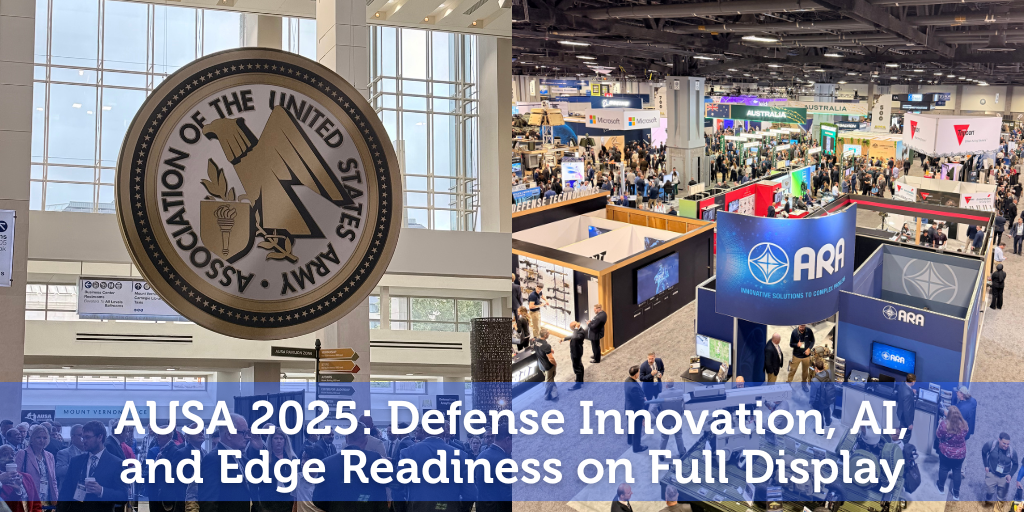 Last week, the Radeus Labs team joined thousands of attendees in Washington, D.C. for the Association of the United States Army (AUSA) Annual Meeting & Exposition, the Army’s largest professional gathering and one of the defense industry’s cornerstone events.
Last week, the Radeus Labs team joined thousands of attendees in Washington, D.C. for the Association of the United States Army (AUSA) Annual Meeting & Exposition, the Army’s largest professional gathering and one of the defense industry’s cornerstone events.
This year’s show carried a sense of urgency that modernization isn’t a far-off goal anymore; it’s happening right now.
Despite worries about a potential government shutdown dampening attendance, the halls were busy and the energy was high. As one of our Technical Sales reps, Clay Moore, put it:
“You couldn’t see where the exhibition floor ended. It just kept going. Every direction you turned, there was something new and impressive to take in.”
Crowds, Hardware, and Hands-On Conversations
 Across the two bustling exhibition floors, defense innovators such as our long-term partner General Atomics, known for its unmanned aircraft systems, and Palantir, recognized for its AI-driven data analytics and command software, drew steady crowds showcasing the technologies shaping the future of defense.
Across the two bustling exhibition floors, defense innovators such as our long-term partner General Atomics, known for its unmanned aircraft systems, and Palantir, recognized for its AI-driven data analytics and command software, drew steady crowds showcasing the technologies shaping the future of defense.
Beyond the impressive displays, what stood out most was the quality of engagement. The Radeus team spent time connecting with hardware manufacturers, IT service providers, and consulting partners who are helping defense organizations bridge physical systems with advanced computing and analytics.
Conversations centered on how to make technology more agile, secure, and mission-ready, themes that closely align with our commitment to ruggedized, high-performance computing for critical environments.
Among the highlights:
- ADS Inc., a defense distributor based in Virginia Beach, had one of the most consistently busy booths, underscoring strong demand for integration partners that can move fast and meet specialized sourcing needs.
- Anduril Industries drew crowds with its Eagle Eye ballistic helmet, a hybrid of armor and embedded computing designed for augmented-reality visualization in combat environments.
- Boston Dynamics’ famous robot dog, Spot, performed within a caged demo area, still one of the most photographed features on the floor.
- Applied Intuition showcased autonomy and mobility software used to automate Humvees and other tactical vehicles, reflecting the Army’s growing focus on self-navigating ground systems.
- Bell presented the V-280 Valor tilt-rotor aircraft, positioned as the next-generation replacement for the Black Hawk helicopter.
Themes That Defined AUSA 2025
Across the show and in leadership briefings, a few messages came through loud and clear:
 Excitement and agility — Despite pre-show uncertainty, enthusiasm for the work being done across the defense industry was unmistakable. Many attendees spoke with optimism about how technology is making systems and procedures more agile, adaptive, and responsive to real-world challenges.
Excitement and agility — Despite pre-show uncertainty, enthusiasm for the work being done across the defense industry was unmistakable. Many attendees spoke with optimism about how technology is making systems and procedures more agile, adaptive, and responsive to real-world challenges.- Counter-UAS and unmanned systems dominated the discussion. Every major exhibitor, from primes to startups, demonstrated drone platforms or anti-drone defenses.
- AI and machine learning were no longer just buzzwords; they were central to nearly every conversation, from logistics to targeting to soldier training.
- “Transformation in Contact” was a recurring phrase. Army leaders emphasized rapid field testing and integration of new technologies, not just concept development.
- Resilience and readiness extended beyond hardware. Soldier quality-of-life programs, installation energy security, and simplification of internal processes (like the newly shortened Army Reg 350-1) all tied back to modernization as a holistic effort.
For Radeus Labs, whose ruggedized, modular computing systems are designed for mission-critical environments, the focus on AI, autonomy, and edge readiness resonated strongly. As Moore summarized:
“It was all about being agile and prepared for the future, facing new kinds of threats and new theaters that demand faster, smarter, more adaptable technology.”
On the Ground: Conversations That Matter
The real value of live events like AUSA isn’t just in the technology on display, it’s in the dialogue. Clay observed that the most engaging conversations centered on how defense organizations and their partners can make systems more integrated, secure, and responsive in real-world conditions.
These discussions reinforced how critical secure, on-premise computing has become across the defense ecosystem, particularly as AI and automation extend closer to the tactical edge.
For Radeus Labs, whose expertise lies in delivering on-premise AI and edge computing systems, these dialogues confirmed that readiness today isn’t just about physical hardware. It’s about having the right compute power, in the right place, at the right time.
Looking Ahead: On-Premise AI at NVIDIA GTC
 Next up, the Radeus team will head to NVIDIA GTC, where AI computing takes center stage. We’re looking forward to connecting with innovators who need on-premise or edge AI compute for applications ranging from simulation and machine learning to autonomous systems and field-deployed analytics.
Next up, the Radeus team will head to NVIDIA GTC, where AI computing takes center stage. We’re looking forward to connecting with innovators who need on-premise or edge AI compute for applications ranging from simulation and machine learning to autonomous systems and field-deployed analytics.
If you’ll be there too, let’s connect. 👉 Schedule a meeting with the Radeus Labs team





